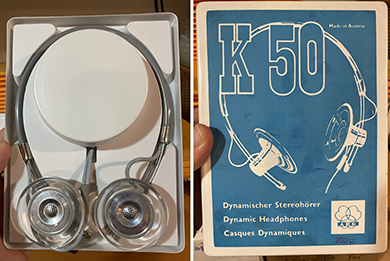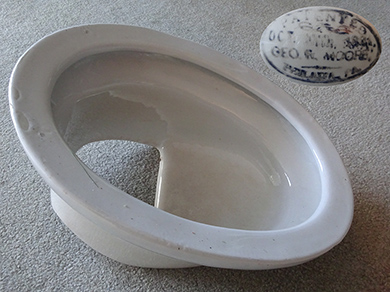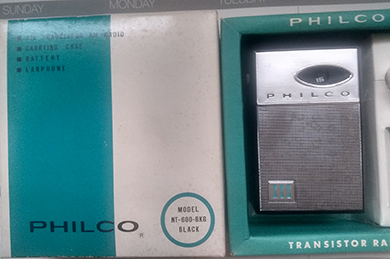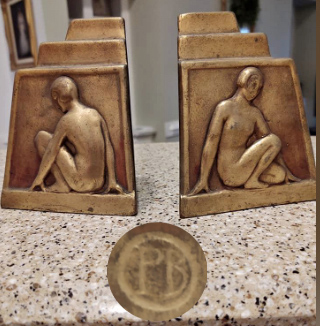 |
|
|||
 |
 |
|||
RINKER ON COLLECTIBLES — Column #1781 Copyright © Harry Rinker, LLC 2021 Questions
and Answers
QUESTION: My father was in the sound business. When I was going through his material, I found a boxed set of K50 AKG headphones. K50s were a pretty early version of stereo headphones for home use. The box lid has a large “K50” in the upper left quadrant imposed over a picture of the headset. The three lines at the bottom left of the box lid read: “Dynamischer Stereohörer / Dynamic Headphones / Casques Dynamiques.” I did not plug them in but have no reason to believe they would not work. I have a bunch of other audio equipment from my dad, much of it dating back to my childhood, and everything else works perfectly. What information can you provide about them? – CJ, CT, Email Question 
ANSWER: Austrians Dr. Rudolf Görike, a physicist, and Ernst Pless, an enginner, founded the Akustische und Kino-Geräte Gesellschaft GmbH (the Acoustic and Cinema Equipment, LLC), commonly known as AKG, in 1947. The company’s initial focus was on manufacturing technical equipment for cinemas – film projectors, light meters, and loudspeakers. As the business expanded the AKG brand was expanded to include car horns, carbon microphone capsules for telephones, cushion speakers, door intercoms, headsets., and microphones. AKG brand microphones were used in cabarets, jazz clubs, radio stations, and theaters. AKG achieved international fame with its introduction of the D12 microphone in 1953. In 1984, AKG became a public company and was listed on the Vienna stock exchange. AKG Acoustics USA was established in 1985. In 1994, Harman International Industries acquired AKG. In 2017, Samsung Electronics bought Harman. Continuing to use the AKG brand, the company makes headphones, microphones, wireless audio systems, and other accessories for the consumer and professional markets. The K50 model headphones were introduced in 1959. They were the world’s first supra-aural and open-back headphones. AKG headphones were continuously upgraded over the years. The K1000, AKG’s flagship model with a fully open design, is no longer made. The K812 is a recent model. Putting all this into perspective, you own a near mint example of one of the iconic stereo headphones. At some point, you need to test the headphones to determine if they are in working condition. This is a value factor. In researching value, I found listings for two pairs of used AKG K50 headphones, one with an asking price of $155.62 and another with a price of $160.55. Neither pair has its period packaging. One of the listings included a series of questions being asked by a potential Austrian or German buyer. The $155.62 listing also included a shipping cost of $43.93, a total of $199.55. Value depends on finding the right buyer. Assuming you can find an audiophile collector who focuses on iconic classics, a fair, secondary market retail value for your AKG 50 headphones is between $200.00 and $250.00. QUESTION: I have an old porcelain toilet seat that I purchased at auction. The auctioneer told me that he crawled into the attic eve of an old home to retrieve it. There is an oval marking with “PATENTED / OCT.____,18__ by / GEO. R. MOORE / PHILADELPHIA, PA.” The seat has no holes to attach it to something. I have shown it to auctioneers, dealers, and plumbers, none of whom was able to tell me anything about it. I also was unable to find the patent. Was it used in an outhouse? Any insights you can provide would be greatly appreciated. – DH, Chambersburg, PA, Email Question 
ANSWER: “Rinker on Collectibles” traditionally focuses on questions dealing with objects made after 1940, although occasionally extends the starting date back to 1900. Having stated this, there was no way I was going to reject a toilet seat history question. George R. Moore of Philadelphia was an inventor with a fascination for water closets among other things. On April 13, 1876, Moore received Patent No. 161,977 for an improved water closet valve, assigning half the rights to Richard Mc Cambridge of Philadelphia. Additional water closet and cistern patents followed in 1876, 1877, 1881, and 1885. Moore also received close to a dozen other patents for improvements to bolts, fire pokers, sink drains, stove grates, and stoves. On October 11, 1881, Moore received Letters Patent No. 248,195 for a “Porcelain Water-Closet Bowl.” He filed the application on March 24, 1879. The patent notes: “The object of my invention is to provide an approved shape for water and air closet bowls…I claim—A porcelain water or air closet bowl with its lower part of oval or oblong shape and nearly vertical walls, and having its outlet-aperture bounded by a straight line across, or nearly across, the bottom portion of the whole bowl, by which the said outlet-aperture is substantially one portion of the bottom of the oval bowl bisected at its shortest line, substantially as and for the purpose herein set forth.” [Author’s Aside: I recently subscribed to Ancestry.com. One of the benefits is access to the US Patent records. The search parameters are very simple. I merely typed in “George R. Moore +Philadelphia” and immediately received a full list of patents issued to him.”] Given Moore’s many patents, I assumed finding his biography on the internet would be a simple matter. It was not. I found several “George R. Moore” biographies but none matched what little I knew about him. Clearly, he died in an era when newspaper obituaries were popular. I searched Newspapers.com. Again, I had no success. As to the value of your George R. Moore patented toilet seat, you most likely established its value when you purchased it at auction. I assumed you paid less than $50.00 and hopefully less than $25.00. Your toilet seat’s primary value is its conversational rather than collectible value, albeit I know only a few individuals who are likely to display it in an area of their home where it would attract enough attention to generate a conversation. In terms of fitting the toilet bowl into a colleting category, my recommendation is “Weird and Strange Things.” QUESTION: I have a Philco transistor radio Model NT-600-BKG in its period box. The box also contains the schematics and a registration card. My father, who lived in north Philadelphia, was a Philco technician. What is the transistor radio worth? – SD, Landsdale, PA, Email Question 
ANSWER: Philco apparently marketed its Model NT-600-BKG transistor radio with a variety of options – individually, with an accompanying leather case, a box set similar to the one you own, and in a box set containing the radio, leather case, and ear buds. The first thing you need to do is determine if the radio still works. All too often batteries were left in the battery chamber, deteriorated, and rusted the battery chamber. Collectors only are interested in examples that work and have no restoration issues. The cost to repair a damaged unit far exceeds its secondary market worth. The radio alone in working condition or with its leather case has a secondary market retail value between $10.00 and $15.00. When doing price research, there always are anomalies. A Model NT-600- BKG with its case sold for $49.00 on October 16, 2020, for $49.00. On March 13, 2020, an example without its case sold through on eBay for $12.00. Box sets containing a working radio sell between $20.00 and $25.00. QUESTION: I have a pair of Pompeian Bronze bookends featuring a pair of seated nude figures in a frame with a two-step top. They are marked “PB” in a circle. Are these Art Deco? How common are they? – L, Email Question 
ANSWER: Art Deco often featured geometric presentations of the human form. The images on your bookends match the criteria. Further, the geometric design of the frame is a design transition between the Arts and Crafts and Art Deco periods. So much for the easy part of the answer. First, I was unable to document the “PB” in a circle as a maker’s mark for Pompeian Bronze. I found several marks but none matched the mark on your bookends. Second, I looked at more than 1,000 images of bronze bookends and/or bronze bookends with nude figures. I found no exact match for your bookends. The bookends are mass-produced, meaning there should be images of them somewhere. Apparently, I did not ask the right “search” questions. I currently am spending the winter at Linda’s and my condo in Altamonte Springs, Florida. My main antiques and collectibles library is back at our home in Michigan. The library contains several reference books for bookends. I have made a note to consult them when I return north in May. Meanwhile, I encourage you not assume these bookends are scarce. This conclusion can be reached only after more research. Perhaps, a “Rinker on Collectibles” reader can supply more information. If available, email it to harrylrinker@aol.com. I will make certain to include it in a future column. Harry L. Rinker welcomes questions from readers about
collectibles, those mass-produced items from the twentieth and twenty-first centuries.
Selected letters will be answered in this column.
Harry cannot provide personal answers.
Photos and other material submitted cannot be
returned.
Send your questions to: Rinker on Collectibles, 5955 Mill
Point Court SE, Kentwood, MI 49512.
You also can e-mail your questions to
harrylrinker@aol.com.
Only e-mails containing a full name and mailing address
will be considered.
|
||||